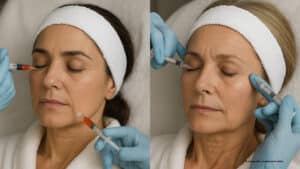Stem cell therapy offers a promising avenue for those seeking effective solutions to hair loss, addressing not only the physical aspect but also the emotional impact of this common concern. Stem cell hair regrowth Los Angeles clinics like Stem Cells LA in Redondo Beach may be able to help you regrow your lost hair using regenerative medicine.
In this bustling metropolis, renowned for its cutting-edge advancements and trendsetting culture, the integration of stem cell technology into hair regrowth treatments represents a significant stride forward in the quest for sustainable hair restoration solutions.
Join us as we explore the exciting world of stem cell hair regrowth in Los Angeles, where science, technology, and beauty converge to redefine
Overview of Hair Loss and Its Impact on Quality of Life
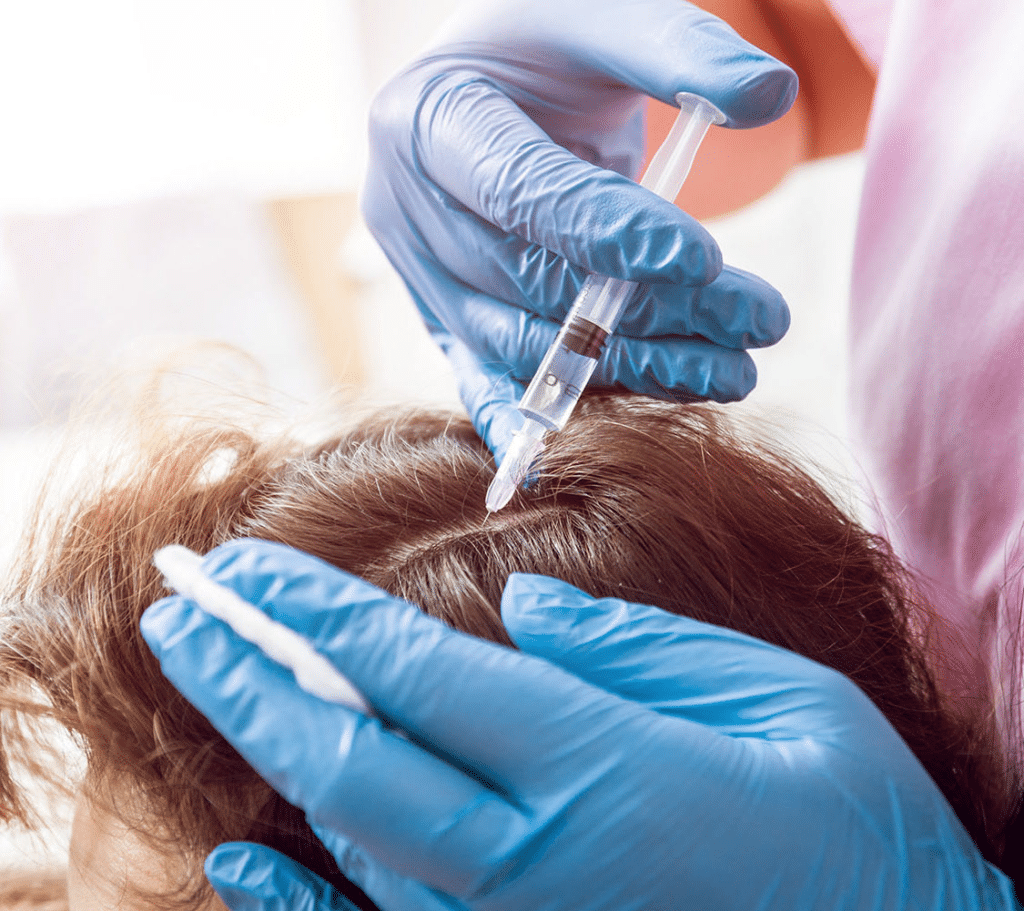
Hair loss, known as alopecia, is a widespread condition affecting many globally, with causes ranging from genetics to medical conditions and environmental factors like stress. It can lead to various patterns of baldness, impacting self-esteem, social interactions, and emotional well-being.
Treatment options include medications, topical solutions, and surgical procedures, but they may not address the underlying causes effectively. Stem cell therapy emerges as a promising alternative by targeting the root cause of hair loss and promoting natural hair regrowth.
Stem cells possess regenerative properties and can rejuvenate dormant hair follicles, offering hope for sustainable hair restoration. Los Angeles, renowned for its focus on beauty and innovation, embraces stem cell therapy as a cutting-edge solution to address hair loss concerns.
Stem cell hair regrowth treatments aim to not only restore hair but also enhance individuals’ confidence and quality of life. By understanding the impact of hair loss and exploring innovative treatments, individuals in Los Angeles can reclaim their vitality and self-assurance.
Stem cell therapy represents a transformative approach in the quest for effective and long-lasting solutions to hair loss, fostering a renewed sense of empowerment and well-being.
Stem Cell Hair Restoration for Thinning Hair Reversal

In the case of hair follicle restoration for thinning hair, scientists may also take a punch biopsy to collect and isolate human adult stem cells that are present within human hair follicles. Studies have found that different parts of the hair follicle contain stem cells that can stimulate hair growth. Our study demonstrates the possibility of stimulating hair growth by regulating cell mechanics.
The latest development in stem cell research concluded that stem cell treatment for hair loss – shows great promise for stimulating new hair growth. While men and women may see some hair loss as they age, some people experience accelerated hair loss that can lead to baldness, thinning hair, and receding hairlines.
Considerations Regarding Stem Cell Treatments for Human Hair Follicles
It’s important to remember that there’s simply not enough data to give you an idea of the success rate of stem cell injections for hair loss — regardless of whether the condition is due to androgenic alopecia or something else. That’s because the use of stem cell treatments for human hair follicles and hair restoration is a new field of study and use for this regenerative medicine application.
However, many patients see great results with stem cell treatment when stimulating hair growth is the goal. Typically, patients may see results within 4-6 months of undergoing treatment for hair follicle growth using stem cell treatment at clinics like Stem Cells LA. Follow-up appointments are recommended in the months following your treatment to monitor your stem cell hair transplant results.
Stem cell-based therapies have recently gained considerable attention as potential novel treatments, focusing on the reactivation of hair follicle stem cells and thus improving the growth, regeneration, and development of hair follicles.
Stem cell hair treatment is a recent development, but scientists have already found unique ways to use stem cells to help hair growth. Stem cell treatments for hair loss heal very fast.
Common Causes of Hair Loss
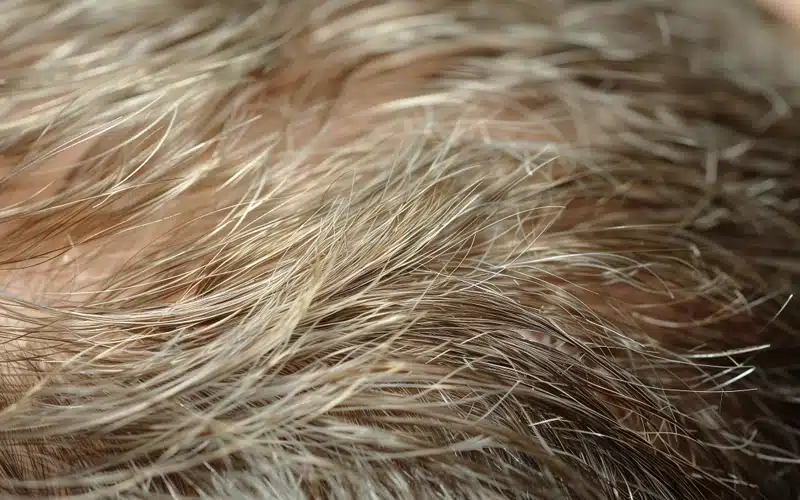
Hair loss, or alopecia, can be attributed to various factors, each affecting hair follicles differently. Here are the common causes:
Genetics: Hereditary hair loss, known as androgenetic alopecia, is the most prevalent cause, affecting both men and women. It occurs due to genetic predisposition and hormonal imbalances.
Hormonal Changes: Fluctuations in hormone levels, such as those occurring during puberty, pregnancy, childbirth, menopause, or thyroid disorders, can lead to hair loss.
Medical Conditions: Certain medical conditions, including autoimmune diseases like alopecia areata, scalp infections, thyroid disorders, and chronic illnesses like lupus or diabetes, can trigger hair loss.
Stress and Trauma: Physical or emotional stress, trauma, or major life events such as surgery, illness, or significant weight loss can disrupt the hair growth cycle, leading to temporary hair loss known as telogen effluvium.
Nutritional Deficiencies: Inadequate intake of essential nutrients like iron, protein, vitamins (especially B vitamins), and minerals (such as zinc and biotin) can impact hair health and contribute to hair loss.
Medications and Treatments: Certain medications, such as chemotherapy drugs, antidepressants, blood thinners, and oral contraceptives, may cause hair loss as a side effect. Additionally, harsh treatments like chemotherapy and radiation therapy can lead to temporary or permanent hair loss.
Age: Hair thinning and loss are natural parts of the aging process, as hair follicles become less active and hair growth slows down with age. This type of hair loss is often referred to as age-related or senescent alopecia.
Understanding the underlying cause of hair loss is crucial for determining the most appropriate treatment approach.
Addressing the root cause, whether through lifestyle modifications, medical interventions, or innovative treatments like stem cell therapy, can help manage hair loss effectively and promote healthy hair growth.
Types of Hair Loss Conditions
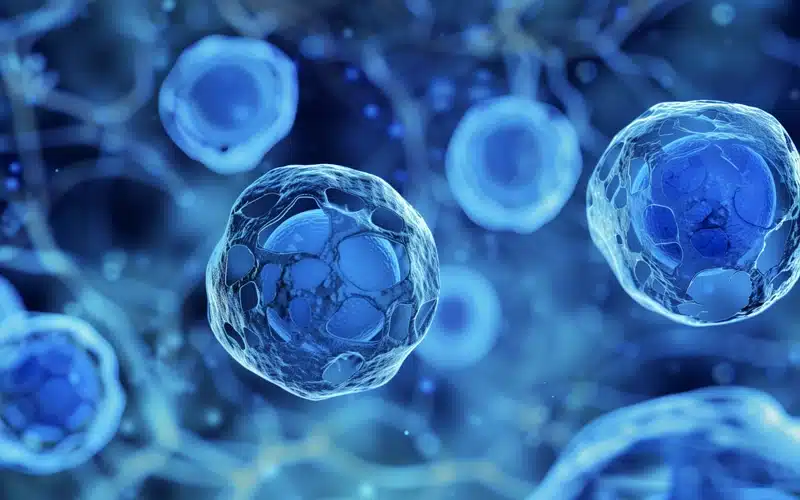
Hair loss, medically termed alopecia, encompasses various types of conditions that affect the hair and scalp. Here are some common types:
Androgenetic Alopecia: Also known as male-pattern or female-pattern baldness, this is the most common type of hair loss, characterized by gradual thinning of hair on the scalp in a specific pattern determined by genetics and hormonal factors.
Alopecia Areata: Alopecia areata is an autoimmune condition where the immune system mistakenly attacks the hair follicles, leading to sudden hair loss in round or oval patches on the scalp or other areas of the body.
Telogen Effluvium: Telogen effluvium is a temporary form of hair loss caused by significant stress, trauma, illness, hormonal changes, or nutritional deficiencies, leading to a larger than usual amount of hair entering the resting (telogen) phase of the hair growth cycle and subsequently shedding.
Traction Alopecia: Traction alopecia results from repeated pulling or tension on the hair follicles, often due to tight hairstyles like braids, ponytails, or hair extensions. Over time, this can lead to hair thinning and loss, particularly along the hairline or in areas of constant tension.
Scarring Alopecia: Scarring alopecia, also known as cicatricial alopecia, refers to hair loss associated with inflammation and destruction of the hair follicles, resulting in irreversible scarring and hair loss. It can be caused by various inflammatory conditions, autoimmune diseases, or infections.
Trichotillomania: Trichotillomania is a psychological disorder characterized by recurrent pulling out of one’s hair, leading to noticeable hair loss and bald patches. It is often considered a form of impulse control disorder.
Anagen Effluvium: Anagen effluvium is a type of hair loss that occurs during the anagen (growth) phase of the hair growth cycle, typically as a side effect of chemotherapy or radiation therapy for cancer treatment. It results in sudden and severe hair shedding.
Understanding the specific type of hair loss condition is crucial for determining the appropriate treatment approach and managing symptoms effectively.
A comprehensive evaluation by a healthcare professional can help diagnose the underlying cause and tailor treatment to address individual needs and concerns.
Stem Cell Therapy for Hair Follicle Regrowth

Stem cell therapy for hair regrowth is an innovative approach that harnesses the regenerative potential of stem cells to stimulate hair follicles’ growth and rejuvenation. Here’s an overview:
Mechanism of Action
Stem cells, particularly mesenchymal stem cells (MSCs), have the ability to differentiate into various cell types and release growth factors and cytokines that promote tissue repair and regeneration. When applied to the scalp, stem cells stimulate dormant hair follicles, prolong the anagen (growth) phase of the hair growth cycle, and promote the formation of new hair follicles.
Types of Stem Cells
Various types of stem cells are used in hair regrowth therapy, including adipose-derived stem cells, bone marrow-derived stem cells, and stem cells from umbilical cord blood. These stem cells can be obtained from the patient’s own tissues or from external sources.
Administration Methods
Stem cell therapy for hair regrowth can be administered through different methods, including direct injection into the scalp, topical application of stem cell-derived products, or combination with other hair restoration techniques such as microneedling or platelet-rich plasma (PRP) therapy.
Benefits of Stem Cell Hair Treatment
Stem cell therapy offers several potential benefits for hair regrowth, including increased hair density, improved hair thickness and texture, and reduced hair shedding. It can also help restore hair in areas of thinning or balding, resulting in a fuller and more natural-looking head of hair.
Safety and Efficacy of Stem Cell Hair Restoration
Clinical studies and trials have demonstrated positive results in some cases, but further research is necessary to optimize treatment protocols and determine the most effective stem cell sources and administration methods.
While stem cell therapy for hair regrowth shows promise, more research is needed to establish its long-term safety and efficacy. However, as long as you seek out a qualified clinic to get your treatment, it is quite rare for stem cell patients looking for hair regeneration to report any negative effects. The majority also report that stem cell hair loss treatments successfully promoted hair growth from both men and women.
Considerations
Patients considering stem cell therapy for hair regrowth should consult with a qualified healthcare provider experienced in hair restoration treatments. Factors such as the underlying cause of hair loss, the extent of hair loss, and individual health status should be considered when determining candidacy for treatment.
Overall, stem cell therapy offers an exciting potential for hair regrowth and restoration, providing hope for individuals experiencing hair loss due to various causes. Continued research and advancements in stem cell technology are expected to further improve treatment outcomes and expand the options available for hair restoration.
Types of Stem Cells Used in Hair Regrowth Therapy

Stem cell therapy for hair regrowth utilizes various types of stem cells with regenerative properties to stimulate hair follicle growth and improve hair density. Here are the common types of stem cells used in hair regrowth therapy:
Mesenchymal Stem Cells (MSCs)
MSCs are multipotent stem cells found in various tissues such as bone marrow, adipose tissue (fat), and umbilical cord blood. They have the ability to differentiate into different cell types, including hair follicle cells, and secrete growth factors and cytokines that promote tissue repair and regeneration.
MSCs are commonly used in hair regrowth therapy due to their regenerative capabilities and ease of isolation from adipose tissue or bone marrow. They work great in tandem with Hair transplantation surgery include Follicular Unit Extraction and Follicular Unit Transplant procedures.
Adipose-Derived Stem Cells (ADSCs)
ADSCs are a type of MSCs obtained from adipose tissue (fat) through minimally invasive liposuction procedures. They possess similar regenerative properties to other MSCs and are often used in hair regrowth therapy due to their abundance in adipose tissue and ease of extraction.
Hematopoietic Stem Cells (HSCs)
HSCs are multipotent stem cells found in bone marrow and are primarily responsible for producing blood cells. While not as commonly used as MSCs in hair regrowth therapy, HSCs have shown potential in stimulating hair follicle growth and improving hair density in preclinical studies.
Induced Pluripotent Stem Cells (iPSCs)
iPSCs are artificially reprogrammed stem cells derived from adult cells, such as skin cells, and have the ability to differentiate into various cell types. They offer the advantage of patient-specific therapy and can potentially be tailored to individual hair regrowth needs.
Amniotic Fluid-Derived Stem Cells
Stem cells derived from amniotic fluid are also being explored for their potential in hair regrowth therapy. These stem cells are obtained from the amniotic fluid surrounding the fetus during pregnancy and are known for their anti-inflammatory and regenerative properties.
Each type of stem cell used in hair regrowth therapy has unique characteristics and potential benefits. The choice of stem cell type may depend on factors such as availability, ease of isolation, and specific therapeutic goals.
Additionally, combination therapies involving multiple types of stem cells or adjunct treatments like platelet-rich plasma (PRP) therapy may be utilized to enhance treatment efficacy and promote optimal hair regrowth outcomes.
Potential Benefits of Stem Cell Therapy
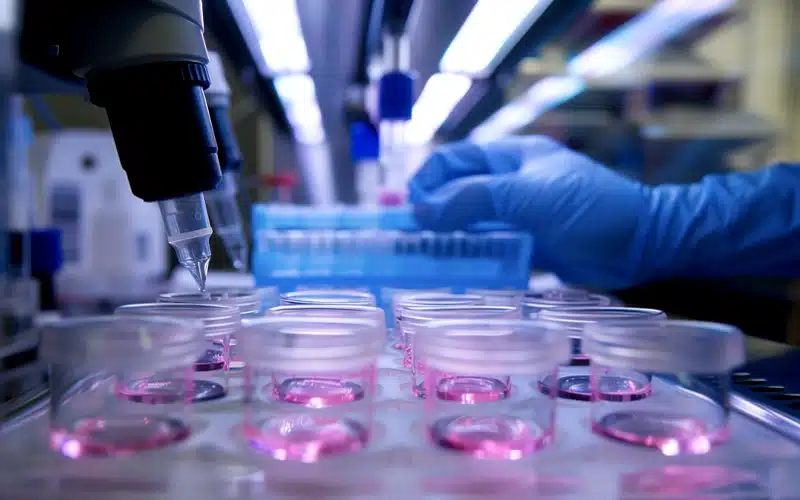
Stem cell therapy for hair regrowth offers a multitude of potential benefits, making it an increasingly attractive option for individuals seeking effective solutions to hair loss:
Natural Hair Regrowth using Stem Cells
Stem cells possess remarkable regenerative properties, capable of activating dormant hair follicles and stimulating the natural growth of new hair strands. Unlike artificial or synthetic treatments, stem cell therapy harnesses the body’s innate healing mechanisms to restore hair growth organically.
Increased Hair Density & Long-lasting Results
Through the revitalization of existing hair follicles and the generation of new ones, stem cell therapy can significantly enhance hair density. This leads to a visibly thicker and fuller appearance, improving overall hair volume and coverage.
Stem cell therapy addresses the root cause of hair loss by rejuvenating and fortifying hair follicles at the cellular level. Consequently, the results of treatment are often durable and enduring, reducing the need for frequent touch-ups or ongoing maintenance sessions.
Minimally Invasive Approach
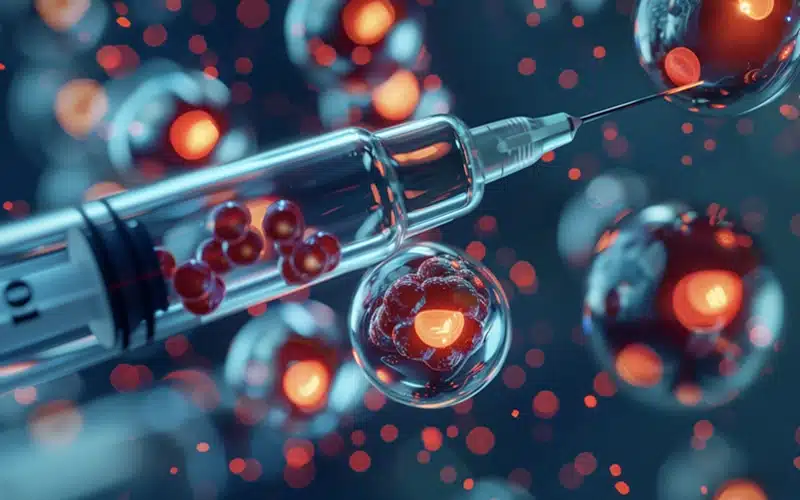
Stem cell therapy for hair regrowth typically involves non-surgical techniques such as injections or topical applications. This minimally invasive approach translates to reduced discomfort, shorter recovery periods, and fewer post-treatment complications compared to traditional surgical interventions.
In fact, most patients looking to use stem cells for hair restoration are in and out of the doctor’s office within an hour or two. That’s because stem cell treatment to stimulate hair growth does not require harsh means to deliver the therapeutic medicine.
Stem cell hair restoration injections are great ways to begin treating male pattern baldness before or after you choose to get a hair transplant surgery. They encourage hair regeneration in either instance so we frequently recommend stem cell treatment for hair follicle regrowth for patients of many different backgrounds with various degrees of thinning hair.
Versatility in Treatment Options
Stem cells can be derived from various sources, including adipose tissue, bone marrow, and umbilical cord blood. This versatility enables healthcare providers to tailor treatment protocols according to individual preferences, needs, and medical considerations, ensuring personalized and effective care.
Safety Profile
Stem cell therapy is generally well-tolerated and safe when administered by qualified healthcare professionals in controlled clinical settings. The use of autologous stem cells, obtained from the patient’s own body, further mitigates the risk of adverse reactions or immune responses, enhancing treatment safety and efficacy.
Potential for Combination Therapies
Stem cell therapy can be synergistically combined with other hair restoration modalities, such as platelet-rich plasma (PRP) therapy or microneedling, to amplify therapeutic outcomes.
This integrated approach addresses multiple aspects of hair loss pathology, maximizing the likelihood of successful treatment outcomes.
In summary, stem cell therapy represents a cutting-edge and promising avenue for individuals grappling with hair loss and those looking to regrow hair. Its array of potential benefits, including natural hair regrowth, increased density, and long-lasting results, positions stem cell regeneration medicine as a leading contender in the realm of hair restoration treatments.
Factors Influencing Treatment Costs in Los Angeles

Several factors can influence the cost of stem cell hair regrowth treatments in Los Angeles. Here are some key factors to consider:
Clinic Reputation and Location: The reputation and location of the clinic can significantly impact treatment costs. Clinics in prime locations or those with a prestigious reputation may charge higher fees for their services.
Treatment Provider Expertise: The qualifications, experience, and expertise of the treatment provider, including hair restoration specialists and medical professionals overseeing the procedure, can influence treatment costs. Providers with extensive experience and advanced training may command higher fees for their services.
Type of Stem Cell Therapy: Different types of stem cell therapy may have varying costs associated with them. Treatments using autologous stem cells (derived from the patient’s own body) may be more expensive than those using allogeneic stem cells (obtained from donor sources).
Treatment Approach and Technology: The specific treatment approach and technology utilized can affect treatment costs. Advanced techniques or technologies, such as automated stem cell processing systems or innovative delivery methods, may result in higher treatment fees.
Extent of Hair Loss: The severity and extent of hair loss can impact the overall cost of treatment. Patients with advanced hair loss or larger treatment areas may require more extensive procedures, leading to higher treatment costs.
Number of Treatment Sessions: Stem cell therapy for hair regrowth often requires multiple treatment sessions to achieve optimal results. The number of sessions needed can vary depending on individual response to treatment and the desired outcome, which can affect the overall cost of treatment.
Additional Services: Some clinics may offer complementary or adjunctive treatments, such as platelet-rich plasma (PRP) therapy, microneedling, or nutritional supplements, to enhance the results of stem cell therapy. These additional services may incur extra costs that should be factored into the overall treatment expenses.
Insurance Coverage and Financing Options: It’s essential to check whether your health insurance plan covers stem cell therapy for hair regrowth. In most cases, elective cosmetic procedures like hair restoration treatments are not covered by insurance, and patients are responsible for covering the full cost of treatment out of pocket. However, many clinics offer financing options or payment plans to help make treatment more affordable for patients.
By considering these factors and discussing treatment options with a qualified hair restoration specialist, patients can gain a better understanding of the treatment costs involved and make informed decisions about their hair restoration journey.
Frequently Asked Questions

What is stem cell hair regrowth therapy?
Stem cell hair regrowth therapy involves the use of stem cells to stimulate dormant hair follicles, promote natural hair regrowth, and improve hair density.
How does stem cell hair regrowth work?
Stem cells have regenerative properties that can rejuvenate hair follicles and promote the growth of new hair strands. When applied to the scalp, stem cells stimulate the hair follicles’ activity, leading to thicker and fuller hair growth.
Is stem cell hair regrowth therapy safe?
Stem cell hair regrowth therapy is generally considered safe when performed by qualified healthcare professionals in controlled clinical settings. However, it’s essential to undergo treatment at reputable clinics with experienced specialists to minimize any risks or complications.
How long does it take to see results from stem cell hair regrowth therapy?
Results from stem cell hair regrowth therapy can vary depending on individual factors such as the extent of hair loss, treatment approach, and response to therapy. Some patients may start to notice improvements in hair density and thickness within a few months of treatment, while others may require longer to see significant results.
Are Stem Cell Hair Restoration Injections the Best Hair Loss Treatments for Everyone?

Stem cell hair regrowth therapy offers a promising solution for individuals struggling with hair loss in Los Angeles. By harnessing the regenerative properties of stem cells, this innovative treatment approach stimulates natural hair growth, improves hair density, and restores confidence in those affected by hair loss.
While further research is needed to optimize treatment protocols and ensure long-term safety and efficacy, stem cell therapy represents a significant advancement in hair restoration technology.
Stem Cells LA – Your Stem Cell Hair Regrowth Los Angeles Specialists
Patients considering stem cell hair regrowth therapy should consult with reputable clinics like Stem Cells LA in Redondo Beach. Our experienced specialists can help you understand and explore treatment options and embark on your journey to healthier, fuller hair.
With proper care and guidance, stem cell hair regrowth therapy holds the potential to transform lives and rejuvenate self-esteem for individuals seeking effective solutions to hair loss in Los Angeles and beyond.
If you’re interested in learning more about stem cell hair regrowth Los Angeles options to restore your hair, reach out to our team by phone or using the form on this site and we’ll happily help you determine if stem cell regenerative medicine is right for you and your hair loss situation.


